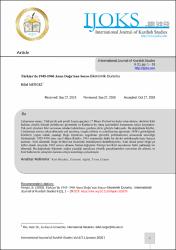| dc.contributor.author | Nergız, Bilal | |
| dc.date.accessioned | 2021-12-12T16:49:10Z | |
| dc.date.available | 2021-12-12T16:49:10Z | |
| dc.date.issued | 2020 | |
| dc.identifier.issn | 2149-2751 | |
| dc.identifier.issn | 2149-2751 | |
| dc.identifier.uri | https://doi.org/10.21600/ijoks.616879 | |
| dc.identifier.uri | https://app.trdizin.gov.tr/makale/TXpZME9UazVPUT09 | |
| dc.identifier.uri | https://hdl.handle.net/20.500.11857/1800 | |
| dc.description.abstract | Çalışmanın amacı, Türkiye’de çok partili hayata geçişten 27 Mayıs Darbesi’ne kadar olan süreçte, devletin Kürthalkına yönelik iktisadi politikasını göstermek ve Kürtlerin bu süreç içerisindeki konumunu ortaya koymaktır.Tek parti yönetimi Kürt sorununa ortadan kaldırılması gereken pürüz gözüyle bakıyordu. Bu doğrultuda Kürtler,Cumhuriyet sonrası erken dönemde yok sayılmış, sürgün edilmiş ve asimilasyona uğramıştı. 1938’e gelindiğindeKürtlerin yoğun olarak yaşadığı Doğu toprakları, uygulanan güvenlik politikalarının sonucunda sessizliğebürünmüştü. 1923-1938 arası zayıf düşen Kürtler, 1945 sonrasında farklı bir devlet politikasıyla karşı karşıyakalmıştı. Yeni dönemde Doğu ile Batı’nın ekonomik bütünleşmesi hedefleniyordu. Yani ulusal pazar Doğu’yanüfuz etmek istiyordu. 1945 sonrası dönem, format değiştiren Türkiye’nin Kürt meselesine farklı yaklaştığı birdönemdi. Bu doğrultuda Kürtlerin yoğun yaşadığı topraklara yönelik gerçekleştirilen yatırımlar ele alınmış veKürt halkının bu süreçteki durumu ortaya konulmaya çalışılmıştır. | en_US |
| dc.description.abstract | This study evaluates the Turkish government’s economic policy toward the Kurds as well as their position during the process. The period considered ranges from the transition to multiparty rule in 1945 to the coup d’état on May 27, 1960. Previously, the one-party administration had considered the Kurds to be a problem that must be eliminated; they were ignored, exiled, and assimilated in the early post-republic period. By 1938, eastern Turkey, where the Kurds largely resided, had been integrated with the west in a geographical sense due to the security policies implemented. The Kurds, who had grown weak in the previous two decades, began to face a new state policy in 1945. The government sought economic integration between the east and the west to allow for the national market to penetrate the east. In the post-1945 period, the government began to look at the Kurdish problem from a new perspective; investments in Kurdish areas were finally being discussed and the plight of the Kurdish people in this process was put forward and considered. | en_US |
| dc.language.iso | tur | en_US |
| dc.relation.ispartof | International Journal of Kurdish Studies | en_US |
| dc.identifier.doi | 10.21600/ijoks.616879 | |
| dc.rights | info:eu-repo/semantics/openAccess | en_US |
| dc.subject | [No Keywords] | en_US |
| dc.title | Türkiye’de 1945-1960 Arası Doğu’nun Sosyo-Ekonomik Durumu | en_US |
| dc.title.alternative | Eastern Turkey’s Socio-Economic Situation Between 1945 and 1960 | en_US |
| dc.type | article | |
| dc.department | Fakülteler, İktisadi ve İdari Bilimler Fakültesi, Uluslararası İlişkiler Bölümü | |
| dc.identifier.volume | 6 | en_US |
| dc.identifier.issue | 1 | en_US |
| dc.identifier.endpage | 19.01.1900 | en_US |
| dc.relation.publicationcategory | Makale - Ulusal Hakemli Dergi - Kurum Öğretim Elemanı | en_US |
| dc.institutionauthor | Nergız, Bilal | |



















